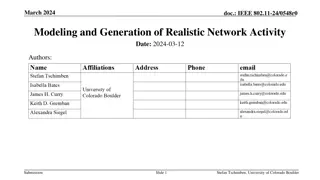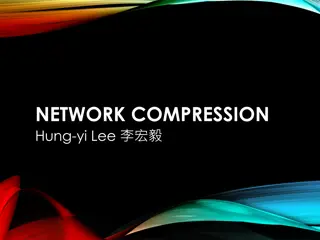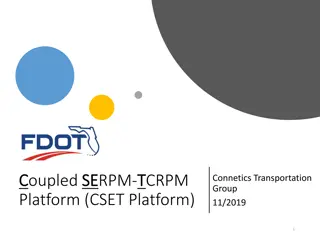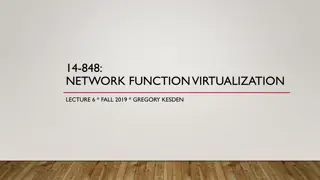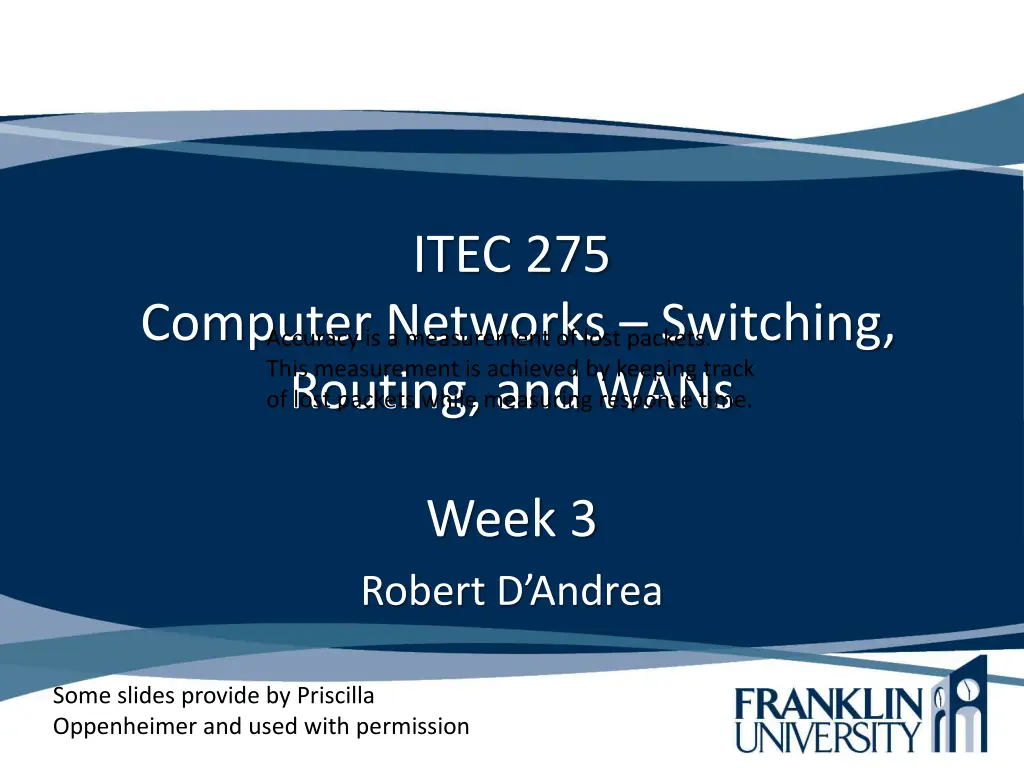
Understanding Network Infrastructure for Design Success
Gain insights into characterizing and mapping existing networks to better determine design goals and ensure realistic outcomes. Explore key aspects such as infrastructure, logical and physical structures, addressing, and more for a successful network design process.
Download Presentation

Please find below an Image/Link to download the presentation.
The content on the website is provided AS IS for your information and personal use only. It may not be sold, licensed, or shared on other websites without obtaining consent from the author. If you encounter any issues during the download, it is possible that the publisher has removed the file from their server.
You are allowed to download the files provided on this website for personal or commercial use, subject to the condition that they are used lawfully. All files are the property of their respective owners.
The content on the website is provided AS IS for your information and personal use only. It may not be sold, licensed, or shared on other websites without obtaining consent from the author.
E N D
Presentation Transcript
ITEC 275 Computer Networks Switching, Routing, and WANs of lost packets while measuring response time. Accuracy is a measurement of lost packets. This measurement is achieved by keeping track Week 3 Robert D Andrea Some slides provide by Priscilla Oppenheimer and used with permission
Agenda Review Learning Activities Analyzing an Existing Network Analyzing Traffic in an Existing Network QoS Introduce homework problems
Whats the Starting Point? According to Abraham Lincoln: If we could first know where we are and whither we are tending, we could better judge what to do and how to do it.
Where Are We? When we characterize the infrastructure of a network, we develop a set of network maps and locate major devices and network segments. Developing a network map should involve understanding traffic flow, performance characteristics of network segments, and insight into where the users are concentrated and the level of traffic a network design must support. Everything you can think of to understand your customers network.
Where Are We? Developing an understanding of your customers existing network s structure, involves it s uses, and behavior, then you have a better chance of determining if you re design goals are realistic.
Where Are We? Characterize the existing internetwork in terms of: Its infrastructure Logical structure (modularity, hierarchy, topology) Physical structure Addressing and naming Wiring and media Architectural and environmental constraints Health
How to Start? Characterization can start by using a top- down approach. Starting with a map or set of maps depicting a high-level abstraction of information Geographical information WAN WAN to LAN Buildings and floors Rooms containing servers, routers, mainframes, and switches Virtual information
How to Start? Characterizing large complex networks should reflect influence from the OSI reference model. A network map should depict applications and services used by the network users. Internal and external web sites Email and external data access entries Ftp operations Printer and file sharing devices DHCP, DNS, SNMP Router interface names, firewalls, NAT, IDS, and IPS
How to Start? Use tools that automate diagram representation of the network. IBM s Tivoli What s Up Gold from ipswitch LAN surveyor Microsoft Visio Professional
Get a Network Map Medford Fast Ethernet 50 users Roseburg Fast Ethernet 30 users Frame Relay CIR = 56 Kbps DLCI = 5 Frame Relay CIR = 56 Kbps DLCI = 4 Grants Pass HQ Gigabit Ethernet Gigabit Ethernet Grants Pass HQ Fast Ethernet 75 users FEP (Front End Processor) IBM Mainframe T1 Web/FTP server Eugene Ethernet 20 users T1 Internet
Characterize Large Internetworks Developing one map might be difficult to do for a large internetwork. Many approaches might be needed for dissecting and understanding the problem. Apply a top-down method influenced by the OSI reference model Develop a series of maps (high to low level) Develop a logical map (shows applications, and services used by network users)
Characterize Large Internetworks Develop a map of internal server functions: Web locations Email sftp Printing File sharing
Characterize Large Internetworks Develop a map of external server functions: Web Email sftp Mobile Web caching servers on your map must be identified because they can affect your traffic flow.
Characterize Large Internetworks Develop a map of network services: Terminal Access Controller Access Control System (TACACS) server(s) Remote Authentication Dial-In User Service (RADIUS) server(s) Dynamic Host Configuration Protocol (DHCP) Domain Name System (DNS) Simple Network Management Protocol (SNMP) Location and reach of virtual private networks (VPN) Dial-in and dial-out servers WAN Internet
Characterize Large Internetworks Develop a map of network services: Layer 3 topology of the internetwork (Cisco notation s0/0 ). This layer of information may reflect a network of devices from a single vendor or a mix of vendors. Protocols Firewalls NAT IDS IPS Layer 2 devices LAN devices and interfaces Public and private WAMs
Characterize a Logical Architecture Determine the logical topology of the network. Is the network flat, hierarchical, structured or unstructured, layered or not. Geometric shape of network (star, spoke, ring, or mesh) Look for ticking time bombs that could affect scalability. These are large layer 2 STP domains that take excessive time to converge. Flat topologies do not scale as well as hierarchical topologies. This affects the ability to upgrade the network.
Characterize a Logical Architecture Enterprise Campus
Characterize a Logical Architecture Enterprise Edge
Characterize Addressing and Naming IP addressing for major devices, client networks, server networks, private needing translation, and so on Any addressing oddities, such as discontinuous subnets? Any strategies for addressing and naming? Route summarization reduces routes in a router For example, sites may be named using airport codes San Francisco = SFO, Oakland = OAK
Characterize Addressing and Naming Route summarization reduces routes in a routing table, routing-table update traffic, and overall router overhead. Route summarization improves network stability and availability, because problems in one area of the network are less likely to affect the whole network. Dis-contiguous subnet is a subnet that has been divided into two areas.
Characterize Addressing and Naming Network addressing scheme might affect the routing protocols. Some routing protocols do not support Classless addressing Variable-length subnet masking (VLSM) Dis-contiguous subnets
Dis-contiguous Subnets Area 0 Network 192.168.49.0 Router A Router B Area 1 Area 2 Subnets 10.108.16.0 - 10.108.31.0 Subnets 10.108.32.0 - 10.108.47.0
Characterize the Wiring and Media Single-mode fiber Multi-mode fiber Shielded twisted pair (STP) copper Unshielded-twisted-pair (UTP) copper Coaxial cable Microwave Laser Radio Infra-red
Characterize the Wiring and Media Topologies: http://www.youtube.com/watch?v=DsPGYvb K8VU Hubs, Switches, and routers http://www.youtube.com/watch?v=Ofjsh_E4H FY
Characterize the Wiring and Media Distance information is critical when selecting data link layer technologies. It is helpful knowing how much copper cable might need to be replaced if fiber cabling is to be used and if there is access for the replacement. Determine the type of wiring used between the wiring closet, cross-connect rooms, and computer rooms.
Characterize the Wiring and Media Vertical wiring run between floors of a building Horizontal wiring run from the wiring closet to the wall plate in the office cubicles. Work-area wiring runs from the wall plate to the workstation.in a cubicle. Generally, the distance from the wiring closet to the workstation are approximately 100 meters.
Characterize the Wiring and Media A time-domain reflectometer (TDR) is used to determine the distance of a cable. It is an electronic instrument that uses time-domain reflective technology to characterize and locate faults in metallic cables (for example, twisted-pair cable or coaxial cable)
Campus Network Wiring Horizontal Wiring Work-Area Wiring Wallplate Telecommunications Wiring Closet Vertical Wiring (Building Backbone) Main Cross-Connect Room (or Main Distribution Frame) Intermediate Cross-Connect Room (or Intermediate Distribution Frame) Campus Backbone Building A - Headquarters Building B
Architectural Constraints Make sure the following are sufficient Air conditioning Heating Ventilation Power Protection from electromagnetic interference Doors that can lock Environmental issues Too close to a right-of-way
Architectural Constraints Parameter Copper Twisted Pair MM Fiber SM Fiber Wireless Distance Up to 100 meters Up to 2 kilometers (Fast Ethernet) Up to 550 m (Gigabit Ethernet) Up to 300 m (10 Gigabit Ethernet) Up to 10 km (Fast Ethernet) Up to 5 km (Gigabit Ethernet) Up to 80 km (10 Gigabit Ethernet) Up to 500 m at 1 Mbps Bandwidth Up to 10 Gigabits per second (Gbps) Up to 10 Gbps Up to 10 Gbps or higher Up to 54 Mbps Price Inexpensive Moderate Moderate to expensive Moderate Deployment Wiring closet Internode or interbuilding Internode or interbuilding Internode or interbuilding
Architectural Constraints Make sure there s space for: Cabling conduits Patch panels Equipment racks Work areas for technicians installing and troubleshooting equipment
Wireless Installation Inspect the architecture and environment constraints of the site to determining the feasibility of a wireless transmission. Wireless transmission is RF (radio frequency) A wireless expert should be hired Network designers can install access points will be located and where the people concentration will be located Access point is based on signal loss between the access point and the user of the access point.
Wireless Installation A wireless site survey is used to describe the process of evaluating the a site to see if it will be appropriate for wireless transmission. An access point is likely to be placed in a location based on an estimate of signal loss that will occur between the access point and the users of the WLAN. An access point is a device that transmits and receives data for users on a WLAN. Generally, it is a point on interconnection between the WLAN and wired Ethernet network.
RF Phenomena Wireless Installations Reflection causes the signal to bounce back on itself. Absorption occurs as the signal passes through materials Refraction is when a signal passes through one medium of one density and then through another medium of another density. Signal will bend. Diffraction when a signal can pass in part through a medium more easily in one part than another
RF Phenomena Wireless Installations A wireless Site Survey should be performed on the existing network for signal propagation, strength, and accuracy in different areas. NIC cards ship with utilities on them to measure signal strength Signal strength can be determined using a protocol analyzer Access points send beacon frames every 100 milliseconds (ms). Use a protocol analyzer to analyze the signal strength being emitted from the different grid locations of the access points.
RF Phenomena Wireless Installations - Use a protocol analyzer to capture CRC errors. These errors stem from corruption and collisions. - Observe if frames are being lost in transmission - Observe the acknowledgment (ACK) and frame retries after a missing ACK. ACK is called a control frame. Clients and access points use them to implement a retransmission mechanism
RF Phenomena Wireless Installations Wired Ethernet Detects collisions through CSMA/CD (802.11) Ethernet uses CSMA/CA as the access method to gain access of the wire. An ACK control frame is returned to a sender for packet received. If a frame does not receive an ACK, it is retransmitted.
Check the Health of the Existing Internetwork Baseline network performance with sufficient time and at a typical time Baseline availability gather information from the customer on MTBF and MTTR Baseline bandwidth utilization during a specific time frame. This is usually a percentage of capacity. Accuracy is an upper layer protocol s responsibility. A frame with a bad CRC is dropped and retransmitted. A good threshold rule for handling errors is that there should be no more than one bad frame per megabyte of data.
Check the Health of the Existing Internetwork -Accuracy is a measurement of lost packets. This measurement is achieved by keeping track of lost packets while measuring response time. -Switches have replaced hubs. - There should be fewer than 0.1 percent of frames encounter collisions. - There should be no late collisions. Indicate bad cabling, cabling longer than 100 meters, bad NIC, or duplex mismatch.
Check the Health of the Existing Internetwork - Auto-negotiation has received it s share of criticism in the past for being inaccurate when setting up a point-to-point link half duplex and full duplex. - Auto-negotiation of speed is usually not a problem. If set up incorrectly, it does not work. The speeds are 10 Mbps, 100 Mbps, or 1000 Mbps.
Check the Health of the Existing Internetwork - Category 3 cable will support 10MBps, but not 100 MBps and higher. Errors increase. Efficiency is linked to large frame sizes. Bandwidth utilization is optimized for efficiency when applications and protocols are in large sized frames. Change window sizes on clients and servers. Increasing maximum transmission unit (MTU). Able to ping and telnet but not be able to send HTTP, and FTP. A hump exist on the sides of the average transmission. Runt frames (less than 64 bytes) are a result of collisions on the same shared Ethernet segment.
Check the Health of the Existing Internetwork Response time can be measured using the round-trip time (RTT)ping command. Observe response time on a user workstation. Run typical applications to get a response. Response time for network services protocols, such as, DHCP and DNS. Status of major routers, switches, and firewalls
Characterize Availability Cause of Last Major Downtime Fix for Last Major Downtime Date and Duration of Last Major Downtime MTBF MTTR Enterprise Segment 1 Segment 2 Segment n
Network Utilization in Minute Intervals Network Utilization 16:40:00 16:43:00 16:46:00 16:49:00 16:52:00 Time 16:55:00 Series1 16:58:00 17:01:00 17:04:00 17:07:00 17:10:00 0 1 2 3 4 5 6 7 Utilization
Network Utilization in Hour Intervals Network Utilization 13:00:00 14:00:00 Time 15:00:00 Series1 16:00:00 17:00:00 0 0.5 1 1.5 2 2.5 3 3.5 4 4.5 Utilization
Bandwidth Utilization by Protocol Relative Network Utilization Absolute Network Utilization Multicast Rate Broadcast Rate Protocol 1 Protocol 2 Protocol 3 Protocol n
Characterize Response Time Node A Node B Node C Node D X Node A X Node B X Node C X Node D
Check the Status of Major Routers, Switches, and Firewalls Show buffers Show environment Show interfaces Show memory Show processes Show running-config Show version

